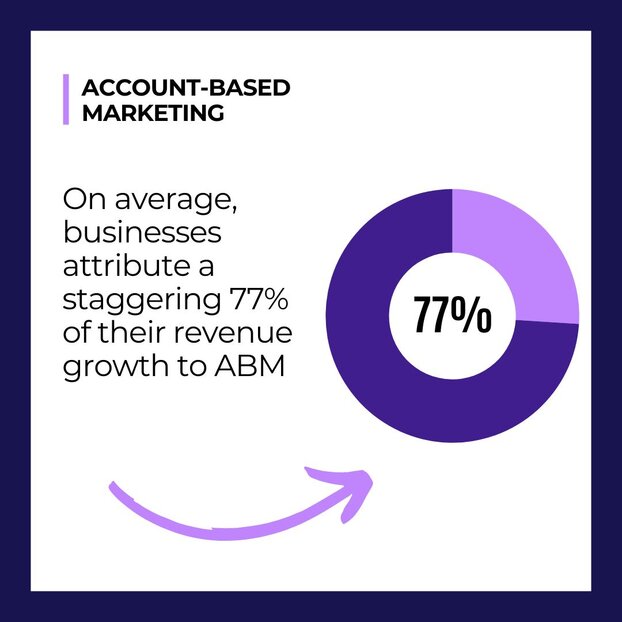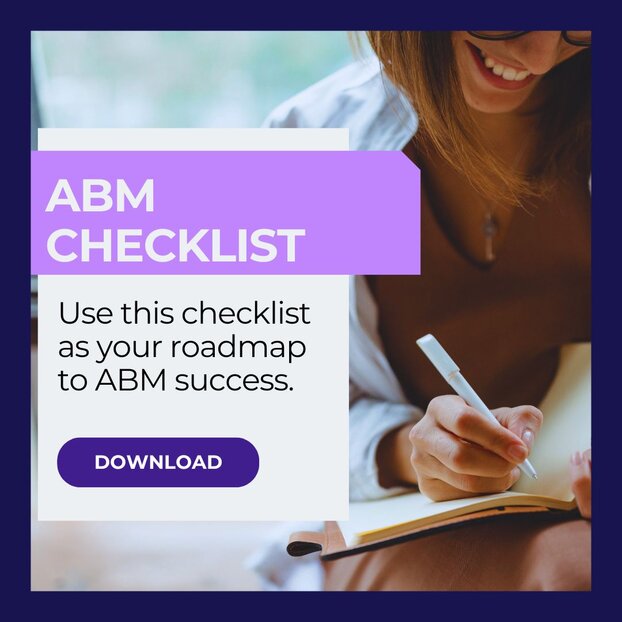How to Win New Key Accounts with Account-Based Marketing
Converting new key accounts represents both a challenge and an opportunity. These accounts often carry the potential for significant revenue, influence, and long-term partnerships. Yet, traditional marketing methods frequently fall short in securing the attention and trust of these high-value targets.
Enter Account-Based Marketing (ABM)—a highly strategic and personalised methodology designed to engage, nurture, and convert specific accounts. By focusing on tailored, high-impact interactions, ABM transforms how businesses approach key account acquisition. This isn’t a quick fix or a one-size-fits-all approach; it’s a precise, data-driven strategy that aligns marketing and sales efforts to meet the evolving demands of modern B2B buyers.
The Challenge: Why Converting New Key Accounts is So Difficult
Converting new key accounts requires more than just a compelling product or service. The hurdles include:
- Complex Buying Committees: Most B2B buying decisions involve multiple stakeholders, often with conflicting priorities. Research shows the typical buying group consists of 6 to 10 decision-makers, adding layers of complexity to the process.
- Information Overload: Decision-makers are inundated with marketing messages. The challenge lies in cutting through this noise to deliver messages that resonate with their specific needs and priorities.
- Independent Buyers: Today’s buyers are highly self-sufficient, spending the majority of their buying journey researching solutions independently before ever engaging with a vendor. This limits opportunities for direct influence and increases the need for precise, value-driven messaging.

These challenges necessitate a smarter, more strategic approach. ABM delivers exactly that by focusing on what matters most to key accounts.
What is ABM? The Framework for Success
Account-Based Marketing is a strategic approach that shifts the focus from broad lead generation to targeted engagement. It treats each key account as its own market, using personalised campaigns to address their specific needs and challenges.
The ABM Framework
- Account Identification: Pinpoint high-value accounts with potential for long-term growth.
- Deep Profiling: Gather insights into each account's industry, goals, and challenges.
- Customised Engagement: Develop bespoke content, messaging, and outreach strategies tailored to each account.
- Multi-Channel Activation: Use a variety of channels to create touchpoints that resonate.
- Ongoing Measurement: Track engagement, pipeline movement, and conversion rates to refine strategies continuously.
Step 1: Identifying and Profiling Key Accounts
The first step in an effective ABM strategy is to identify the accounts that matter most. Not every prospect qualifies as a "key account," so this process involves careful selection based on strategic fit and potential impact.
Qualifying Key Accounts
- Revenue Potential: Is this account capable of generating significant revenue for your business?
- Strategic Fit: Do their goals and challenges align with your unique value proposition?
- Market Influence: Does winning this account offer credibility or access to new markets?
- Engagement Indicators: Have they shown interest in your brand through content consumption or event attendance?
Once identified, detailed profiling is essential. This includes gathering data on:
- Organisational priorities.
- Decision-making processes.
- Pain points and challenges.
- Preferred communication channels.
This comprehensive understanding ensures that every interaction is relevant and impactful.
Step 2: Creating Hyper-Personalised Strategies
ABM’s effectiveness hinges on personalisation. Today’s buyers expect tailored solutions that speak directly to their unique challenges and objectives.
Tactics for Personalisation
- Account-Specific Content: Create materials like tailored case studies, industry-specific reports, or custom landing pages that directly address an account's needs.
- Stakeholder-Centric Messaging: Recognise that different stakeholders have different priorities. Personalise messaging to resonate with each decision-maker, whether it’s financial ROI for the CFO or operational efficiency for the IT manager.
- Pain Point Resolution: Showcase how your solutions address their most pressing challenges, backed by data and examples.
By focusing on hyper-relevant content and messaging, ABM moves beyond generic outreach to create meaningful, engaging experiences.

Step 3: Aligning Sales and Marketing for Seamless Execution
ABM requires seamless collaboration between sales and marketing teams. Misalignment can lead to disjointed efforts that fail to create a cohesive experience for key accounts.
Key Alignment Strategies
- Shared Objectives: Define clear, measurable goals that both teams are accountable for, such as increasing engagement or closing specific accounts.
- Unified Messaging: Develop consistent messaging frameworks to ensure alignment across all touchpoints.
- Technology Integration: Leverage platforms like HubSpot or Marketo to centralise account data and enable cross-team collaboration.
- Regular Check-Ins: Host ongoing alignment meetings to review progress, share insights, and adjust strategies as needed.
Research shows that organisations with strong sales-marketing alignment achieve 24% faster revenue growth than their peers, underscoring its critical importance in ABM.
Step 4: Engaging Key Accounts Across Multiple Channels
Key accounts engage with brands through a variety of channels, from LinkedIn and email to industry events and direct mail. A multi-channel strategy ensures that you meet them where they are, delivering consistent and relevant messaging.
Multi-Channel Activation Tactics
- Social Media Targeting: Use LinkedIn to run account-specific ads and engage stakeholders directly.
- Personalised Email Campaigns: Send tailored email sequences that evolve based on recipient engagement.
- Events and Webinars: Host exclusive events or webinars that address challenges specific to the account's industry.
- High-Impact Direct Mail: Send personalised packages or handwritten notes to key stakeholders for a memorable touch.
The key to success lies in creating a cohesive narrative across channels, ensuring that every touchpoint builds upon the last.
Step 5: Measuring Success and Continuous Optimisation
Measurement is the backbone of any ABM strategy. It provides insights into what’s working, what’s not, and where adjustments are needed to maximise impact.
Metrics to Track
- Engagement Rates: Monitor how frequently and meaningfully key accounts interact with your campaigns.
- Pipeline Velocity: Measure how quickly accounts move through the sales pipeline.
- Conversion Rates: Track the percentage of targeted accounts that become customers.
- Account Lifetime Value (ALV): Evaluate the long-term revenue potential of each account.
By analysing these metrics, you can refine your approach, doubling down on what works and pivoting away from ineffective tactics.
Account-Based Marketing Framework
Defining Objectives and KPIs
The first step in an ABM strategy is to clearly define your objectives and key performance indicators (KPIs). Objectives could include increasing revenue from key accounts, improving customer retention, or penetrating new market segments. KPIs should be aligned with these objectives and could range from engagement metrics (e.g., email open rates, website visits) to financial metrics (e.g., deal size, revenue growth).
Identifying Target Accounts
Identifying and selecting the right accounts is critical. Use data-driven insights to pinpoint accounts that align with your business goals and have the highest potential for revenue generation. Consider factors such as company size, industry, geographic location, and buying behaviour. In the APAC region, leveraging local market intelligence and cultural nuances can significantly enhance account selection accuracy.
Developing Personalised Content
Content is the backbone of ABM. For each target account or cluster, develop highly personalised content that addresses their specific needs, pain points, and goals. This can include custom landing pages, tailored email campaigns, personalised webinars, and bespoke case studies. Personalisation increases engagement and demonstrates your commitment to understanding and solving the account’s unique challenges.
Aligning Sales and Marketing Efforts
Successful ABM requires seamless collaboration between sales and marketing teams. Both teams should work together to develop account plans, share insights, and align on messaging. Regular meetings and integrated workflows ensure that efforts are coordinated and that accounts receive a consistent experience across touchpoints.
Implementing Multi-Channel Campaigns
An effective ABM strategy leverages multiple channels to engage target accounts. This includes digital channels like email, social media, and paid ads, as well as direct channels like events, webinars, and personalised direct mail. In the APAC region, consider incorporating local social media platforms and regional events to enhance engagement.
Utilising Technology and Tools
ABM platforms and tools play a crucial role in executing and scaling ABM campaigns. To manage and measure campaigns, utilise technologies like CRM systems, marketing automation platforms, and ABM-specific tools. These tools enable data-driven decision-making and provide insights into account engagement and campaign performance.
Measuring and Optimising
Regular measurement and optimisation are essential to ensure the success of ABM campaigns. Track KPIs and analyse the performance of each campaign. Use insights to refine your strategy, improve targeting, and enhance personalisation. Continuous optimisation ensures that your ABM efforts remain effective and deliver maximum ROI.
Turning Precision into Growth with Account-Based Marketing on HubSpot
Account-Based Marketing (ABM) is not just a strategy; it’s a paradigm shift in how we engage, nurture, and convert key accounts. To succeed with ABM, businesses need meticulous planning, seamless collaboration, and sustained engagement that resonates with high-value accounts.
HubSpot’s ABM tools allow you to bring this vision to life, equipping your team to go beyond lead generation and focus on building genuine connections that last.
By understanding the different types of ABM and leveraging HubSpot’s features to tailor your outreach, businesses can craft a strategy that speaks directly to each account’s unique needs. From developing hyper-targeted lists and personalising workflows, to aligning sales and marketing, HubSpot provides the ideal foundation to manage ABM campaigns with precision and insight.

